A Comprehensive Report: Finance and Funding in Travel and Tourism
VerifiedAdded on 2020/02/03
|18
|5239
|30
Report
AI Summary
This report delves into the financial intricacies of the travel and tourism sector, focusing on Carib Happy Tours Company (CHTC). It begins with an introduction to the significance of finance and its role in managerial decision-making, emphasizing cost analysis, CVP analysis, break-even points, and pricing strategies like cost-plus and market-led pricing. The report also explores the impact of factors such as competition, legislation, marketing, and demand on profitability. Furthermore, it examines capital budgeting techniques for investment decisions and various funding sources, including internal and external options, to meet CHTC's financial requirements for constructing a new hotel. The report provides a comprehensive overview of financial planning and management in the tourism industry.
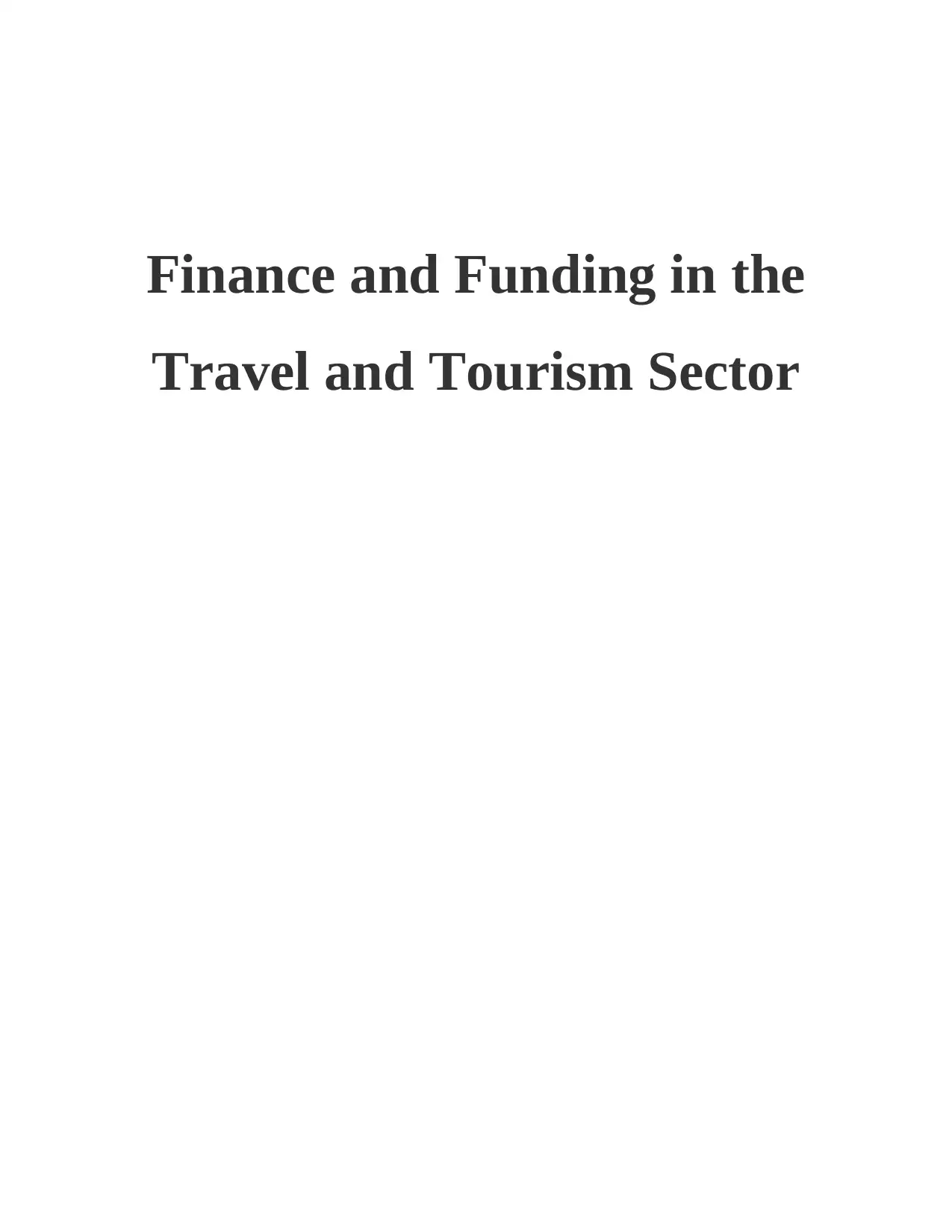
Finance and Funding in the
Travel and Tourism Sector
Travel and Tourism Sector
Paraphrase This Document
Need a fresh take? Get an instant paraphrase of this document with our AI Paraphraser

Table of Contents
INTRODUCTION...........................................................................................................................3
TASK 1............................................................................................................................................3
1.1................................................................................................................................................3
1.2................................................................................................................................................5
1.3................................................................................................................................................7
TASK 2............................................................................................................................................9
2.1................................................................................................................................................9
2.2..............................................................................................................................................10
TASK 3..........................................................................................................................................12
3.1..............................................................................................................................................12
TASK 4..........................................................................................................................................15
4.1..............................................................................................................................................15
CONCLUSION..............................................................................................................................16
REFERENCES..............................................................................................................................17
2
INTRODUCTION...........................................................................................................................3
TASK 1............................................................................................................................................3
1.1................................................................................................................................................3
1.2................................................................................................................................................5
1.3................................................................................................................................................7
TASK 2............................................................................................................................................9
2.1................................................................................................................................................9
2.2..............................................................................................................................................10
TASK 3..........................................................................................................................................12
3.1..............................................................................................................................................12
TASK 4..........................................................................................................................................15
4.1..............................................................................................................................................15
CONCLUSION..............................................................................................................................16
REFERENCES..............................................................................................................................17
2
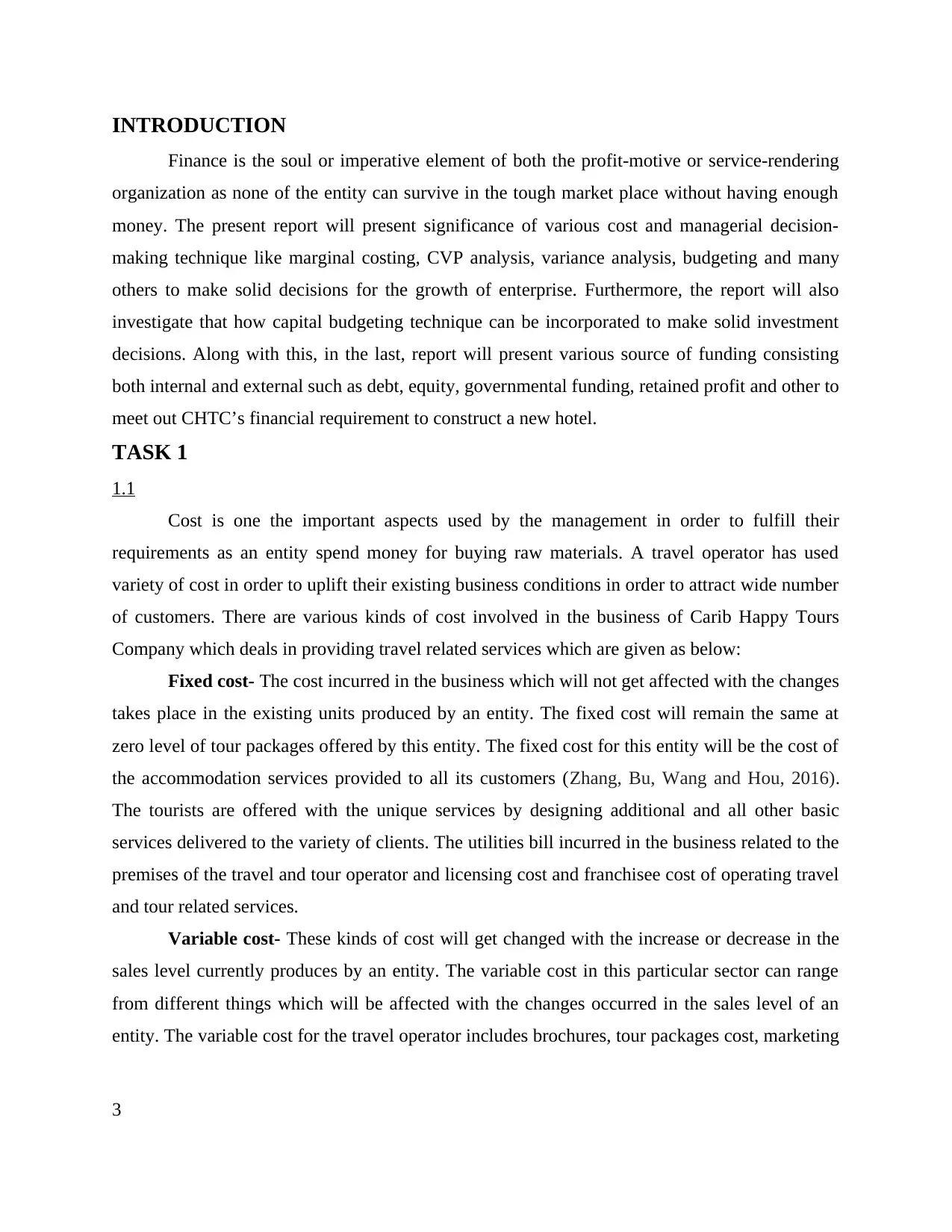
INTRODUCTION
Finance is the soul or imperative element of both the profit-motive or service-rendering
organization as none of the entity can survive in the tough market place without having enough
money. The present report will present significance of various cost and managerial decision-
making technique like marginal costing, CVP analysis, variance analysis, budgeting and many
others to make solid decisions for the growth of enterprise. Furthermore, the report will also
investigate that how capital budgeting technique can be incorporated to make solid investment
decisions. Along with this, in the last, report will present various source of funding consisting
both internal and external such as debt, equity, governmental funding, retained profit and other to
meet out CHTC’s financial requirement to construct a new hotel.
TASK 1
1.1
Cost is one the important aspects used by the management in order to fulfill their
requirements as an entity spend money for buying raw materials. A travel operator has used
variety of cost in order to uplift their existing business conditions in order to attract wide number
of customers. There are various kinds of cost involved in the business of Carib Happy Tours
Company which deals in providing travel related services which are given as below:
Fixed cost- The cost incurred in the business which will not get affected with the changes
takes place in the existing units produced by an entity. The fixed cost will remain the same at
zero level of tour packages offered by this entity. The fixed cost for this entity will be the cost of
the accommodation services provided to all its customers (Zhang, Bu, Wang and Hou, 2016).
The tourists are offered with the unique services by designing additional and all other basic
services delivered to the variety of clients. The utilities bill incurred in the business related to the
premises of the travel and tour operator and licensing cost and franchisee cost of operating travel
and tour related services.
Variable cost- These kinds of cost will get changed with the increase or decrease in the
sales level currently produces by an entity. The variable cost in this particular sector can range
from different things which will be affected with the changes occurred in the sales level of an
entity. The variable cost for the travel operator includes brochures, tour packages cost, marketing
3
Finance is the soul or imperative element of both the profit-motive or service-rendering
organization as none of the entity can survive in the tough market place without having enough
money. The present report will present significance of various cost and managerial decision-
making technique like marginal costing, CVP analysis, variance analysis, budgeting and many
others to make solid decisions for the growth of enterprise. Furthermore, the report will also
investigate that how capital budgeting technique can be incorporated to make solid investment
decisions. Along with this, in the last, report will present various source of funding consisting
both internal and external such as debt, equity, governmental funding, retained profit and other to
meet out CHTC’s financial requirement to construct a new hotel.
TASK 1
1.1
Cost is one the important aspects used by the management in order to fulfill their
requirements as an entity spend money for buying raw materials. A travel operator has used
variety of cost in order to uplift their existing business conditions in order to attract wide number
of customers. There are various kinds of cost involved in the business of Carib Happy Tours
Company which deals in providing travel related services which are given as below:
Fixed cost- The cost incurred in the business which will not get affected with the changes
takes place in the existing units produced by an entity. The fixed cost will remain the same at
zero level of tour packages offered by this entity. The fixed cost for this entity will be the cost of
the accommodation services provided to all its customers (Zhang, Bu, Wang and Hou, 2016).
The tourists are offered with the unique services by designing additional and all other basic
services delivered to the variety of clients. The utilities bill incurred in the business related to the
premises of the travel and tour operator and licensing cost and franchisee cost of operating travel
and tour related services.
Variable cost- These kinds of cost will get changed with the increase or decrease in the
sales level currently produces by an entity. The variable cost in this particular sector can range
from different things which will be affected with the changes occurred in the sales level of an
entity. The variable cost for the travel operator includes brochures, tour packages cost, marketing
3
⊘ This is a preview!⊘
Do you want full access?
Subscribe today to unlock all pages.

Trusted by 1+ million students worldwide
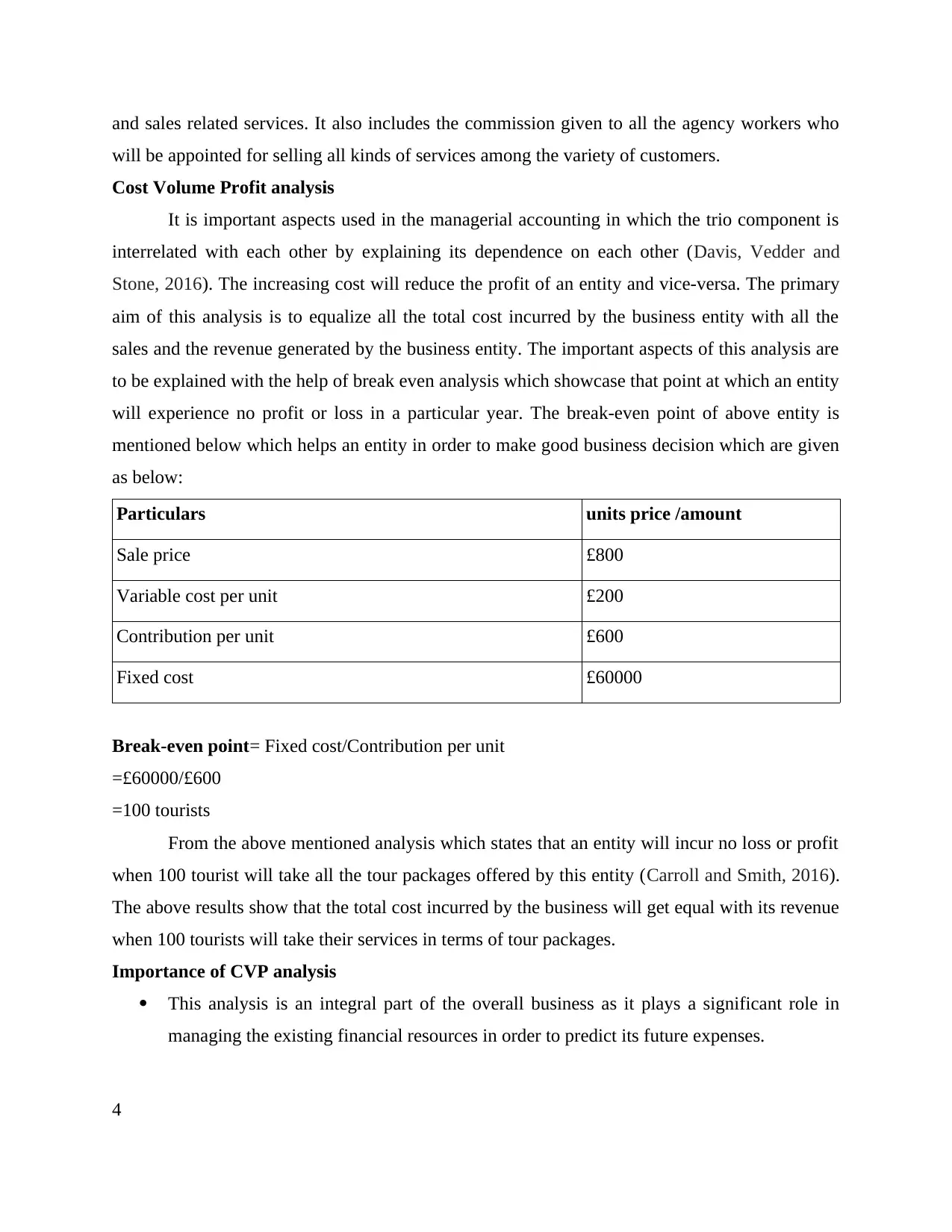
and sales related services. It also includes the commission given to all the agency workers who
will be appointed for selling all kinds of services among the variety of customers.
Cost Volume Profit analysis
It is important aspects used in the managerial accounting in which the trio component is
interrelated with each other by explaining its dependence on each other (Davis, Vedder and
Stone, 2016). The increasing cost will reduce the profit of an entity and vice-versa. The primary
aim of this analysis is to equalize all the total cost incurred by the business entity with all the
sales and the revenue generated by the business entity. The important aspects of this analysis are
to be explained with the help of break even analysis which showcase that point at which an entity
will experience no profit or loss in a particular year. The break-even point of above entity is
mentioned below which helps an entity in order to make good business decision which are given
as below:
Particulars units price /amount
Sale price £800
Variable cost per unit £200
Contribution per unit £600
Fixed cost £60000
Break-even point= Fixed cost/Contribution per unit
=£60000/£600
=100 tourists
From the above mentioned analysis which states that an entity will incur no loss or profit
when 100 tourist will take all the tour packages offered by this entity (Carroll and Smith, 2016).
The above results show that the total cost incurred by the business will get equal with its revenue
when 100 tourists will take their services in terms of tour packages.
Importance of CVP analysis
This analysis is an integral part of the overall business as it plays a significant role in
managing the existing financial resources in order to predict its future expenses.
4
will be appointed for selling all kinds of services among the variety of customers.
Cost Volume Profit analysis
It is important aspects used in the managerial accounting in which the trio component is
interrelated with each other by explaining its dependence on each other (Davis, Vedder and
Stone, 2016). The increasing cost will reduce the profit of an entity and vice-versa. The primary
aim of this analysis is to equalize all the total cost incurred by the business entity with all the
sales and the revenue generated by the business entity. The important aspects of this analysis are
to be explained with the help of break even analysis which showcase that point at which an entity
will experience no profit or loss in a particular year. The break-even point of above entity is
mentioned below which helps an entity in order to make good business decision which are given
as below:
Particulars units price /amount
Sale price £800
Variable cost per unit £200
Contribution per unit £600
Fixed cost £60000
Break-even point= Fixed cost/Contribution per unit
=£60000/£600
=100 tourists
From the above mentioned analysis which states that an entity will incur no loss or profit
when 100 tourist will take all the tour packages offered by this entity (Carroll and Smith, 2016).
The above results show that the total cost incurred by the business will get equal with its revenue
when 100 tourists will take their services in terms of tour packages.
Importance of CVP analysis
This analysis is an integral part of the overall business as it plays a significant role in
managing the existing financial resources in order to predict its future expenses.
4
Paraphrase This Document
Need a fresh take? Get an instant paraphrase of this document with our AI Paraphraser
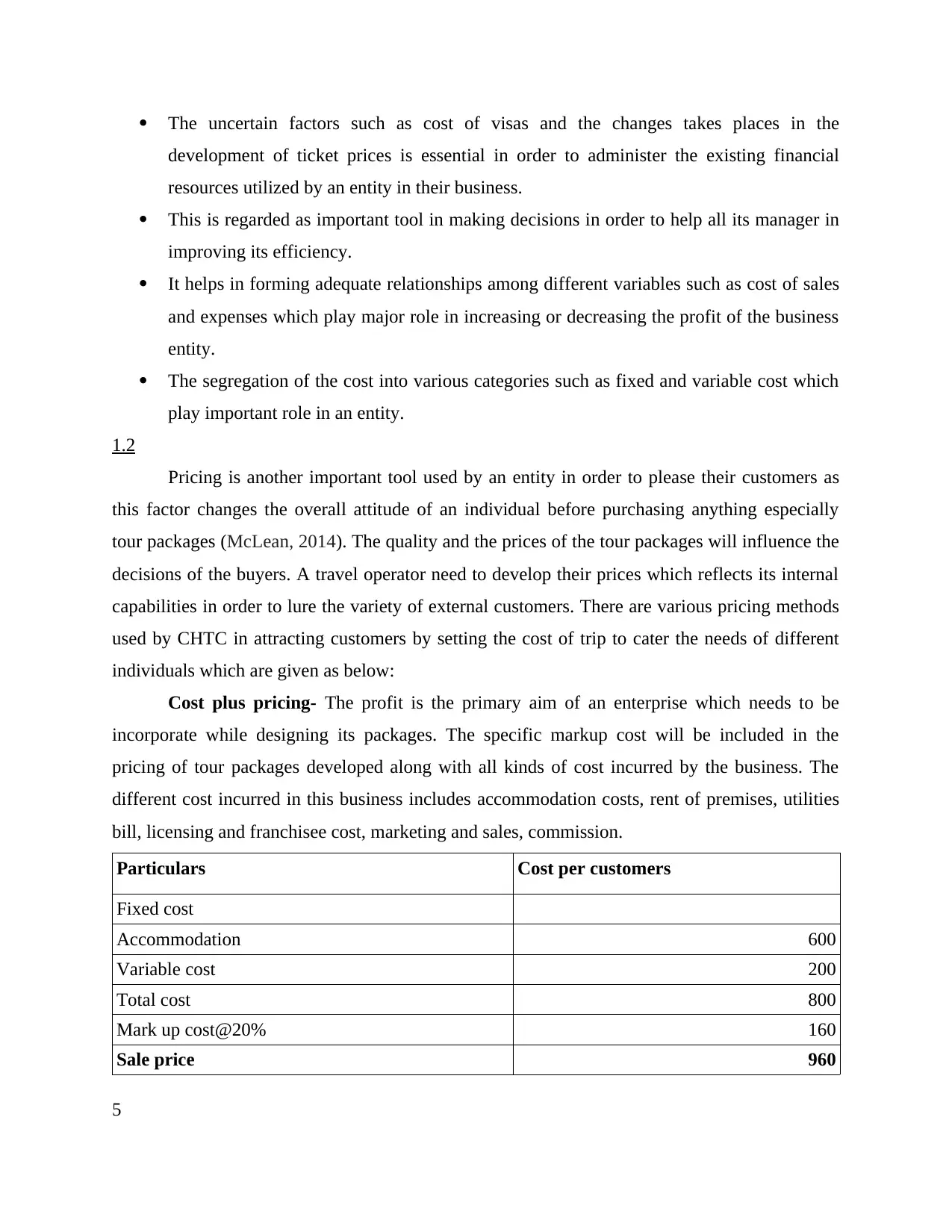
The uncertain factors such as cost of visas and the changes takes places in the
development of ticket prices is essential in order to administer the existing financial
resources utilized by an entity in their business.
This is regarded as important tool in making decisions in order to help all its manager in
improving its efficiency.
It helps in forming adequate relationships among different variables such as cost of sales
and expenses which play major role in increasing or decreasing the profit of the business
entity.
The segregation of the cost into various categories such as fixed and variable cost which
play important role in an entity.
1.2
Pricing is another important tool used by an entity in order to please their customers as
this factor changes the overall attitude of an individual before purchasing anything especially
tour packages (McLean, 2014). The quality and the prices of the tour packages will influence the
decisions of the buyers. A travel operator need to develop their prices which reflects its internal
capabilities in order to lure the variety of external customers. There are various pricing methods
used by CHTC in attracting customers by setting the cost of trip to cater the needs of different
individuals which are given as below:
Cost plus pricing- The profit is the primary aim of an enterprise which needs to be
incorporate while designing its packages. The specific markup cost will be included in the
pricing of tour packages developed along with all kinds of cost incurred by the business. The
different cost incurred in this business includes accommodation costs, rent of premises, utilities
bill, licensing and franchisee cost, marketing and sales, commission.
Particulars Cost per customers
Fixed cost
Accommodation 600
Variable cost 200
Total cost 800
Mark up cost@20% 160
Sale price 960
5
development of ticket prices is essential in order to administer the existing financial
resources utilized by an entity in their business.
This is regarded as important tool in making decisions in order to help all its manager in
improving its efficiency.
It helps in forming adequate relationships among different variables such as cost of sales
and expenses which play major role in increasing or decreasing the profit of the business
entity.
The segregation of the cost into various categories such as fixed and variable cost which
play important role in an entity.
1.2
Pricing is another important tool used by an entity in order to please their customers as
this factor changes the overall attitude of an individual before purchasing anything especially
tour packages (McLean, 2014). The quality and the prices of the tour packages will influence the
decisions of the buyers. A travel operator need to develop their prices which reflects its internal
capabilities in order to lure the variety of external customers. There are various pricing methods
used by CHTC in attracting customers by setting the cost of trip to cater the needs of different
individuals which are given as below:
Cost plus pricing- The profit is the primary aim of an enterprise which needs to be
incorporate while designing its packages. The specific markup cost will be included in the
pricing of tour packages developed along with all kinds of cost incurred by the business. The
different cost incurred in this business includes accommodation costs, rent of premises, utilities
bill, licensing and franchisee cost, marketing and sales, commission.
Particulars Cost per customers
Fixed cost
Accommodation 600
Variable cost 200
Total cost 800
Mark up cost@20% 160
Sale price 960
5
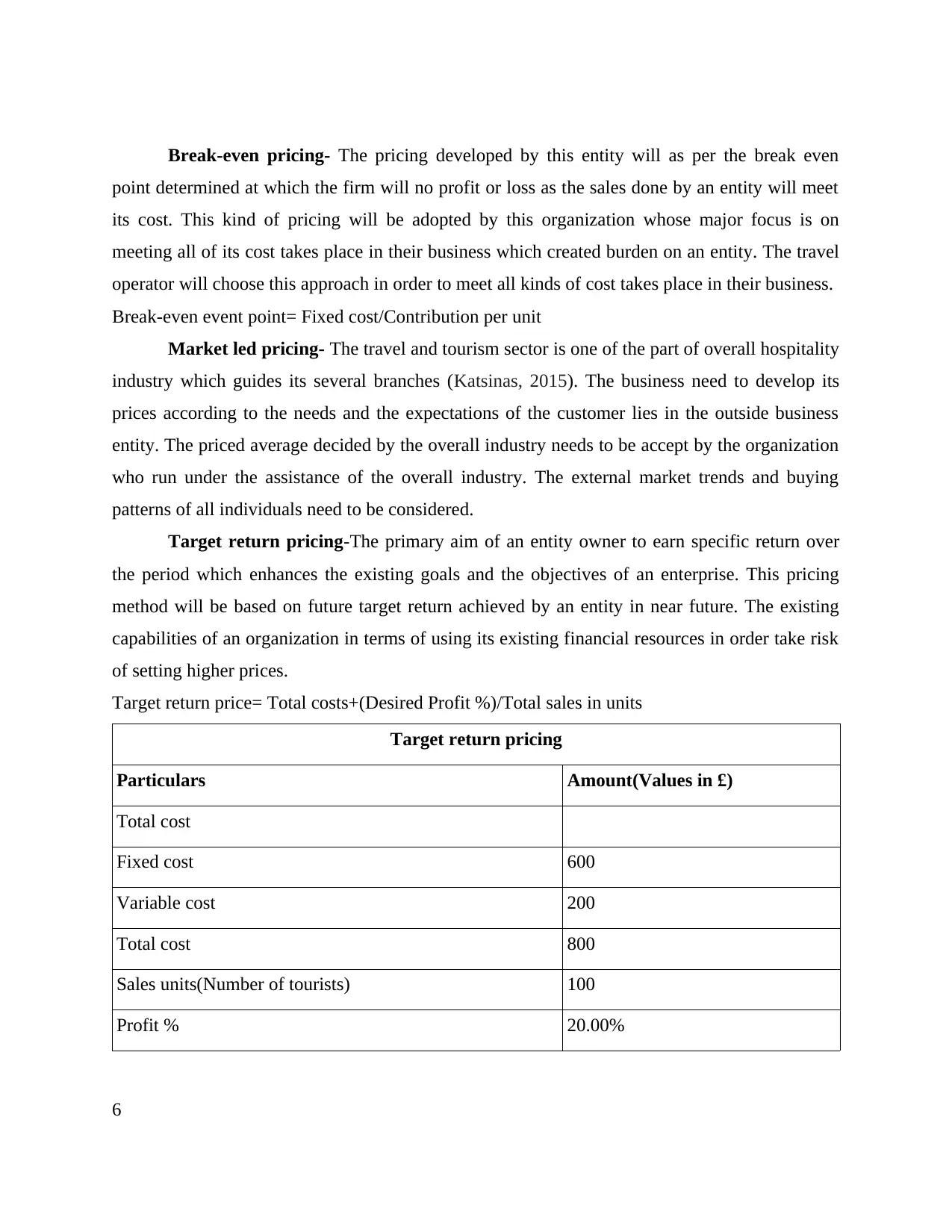
Break-even pricing- The pricing developed by this entity will as per the break even
point determined at which the firm will no profit or loss as the sales done by an entity will meet
its cost. This kind of pricing will be adopted by this organization whose major focus is on
meeting all of its cost takes place in their business which created burden on an entity. The travel
operator will choose this approach in order to meet all kinds of cost takes place in their business.
Break-even event point= Fixed cost/Contribution per unit
Market led pricing- The travel and tourism sector is one of the part of overall hospitality
industry which guides its several branches (Katsinas, 2015). The business need to develop its
prices according to the needs and the expectations of the customer lies in the outside business
entity. The priced average decided by the overall industry needs to be accept by the organization
who run under the assistance of the overall industry. The external market trends and buying
patterns of all individuals need to be considered.
Target return pricing-The primary aim of an entity owner to earn specific return over
the period which enhances the existing goals and the objectives of an enterprise. This pricing
method will be based on future target return achieved by an entity in near future. The existing
capabilities of an organization in terms of using its existing financial resources in order take risk
of setting higher prices.
Target return price= Total costs+(Desired Profit %)/Total sales in units
Target return pricing
Particulars Amount(Values in £)
Total cost
Fixed cost 600
Variable cost 200
Total cost 800
Sales units(Number of tourists) 100
Profit % 20.00%
6
point determined at which the firm will no profit or loss as the sales done by an entity will meet
its cost. This kind of pricing will be adopted by this organization whose major focus is on
meeting all of its cost takes place in their business which created burden on an entity. The travel
operator will choose this approach in order to meet all kinds of cost takes place in their business.
Break-even event point= Fixed cost/Contribution per unit
Market led pricing- The travel and tourism sector is one of the part of overall hospitality
industry which guides its several branches (Katsinas, 2015). The business need to develop its
prices according to the needs and the expectations of the customer lies in the outside business
entity. The priced average decided by the overall industry needs to be accept by the organization
who run under the assistance of the overall industry. The external market trends and buying
patterns of all individuals need to be considered.
Target return pricing-The primary aim of an entity owner to earn specific return over
the period which enhances the existing goals and the objectives of an enterprise. This pricing
method will be based on future target return achieved by an entity in near future. The existing
capabilities of an organization in terms of using its existing financial resources in order take risk
of setting higher prices.
Target return price= Total costs+(Desired Profit %)/Total sales in units
Target return pricing
Particulars Amount(Values in £)
Total cost
Fixed cost 600
Variable cost 200
Total cost 800
Sales units(Number of tourists) 100
Profit % 20.00%
6
⊘ This is a preview!⊘
Do you want full access?
Subscribe today to unlock all pages.

Trusted by 1+ million students worldwide
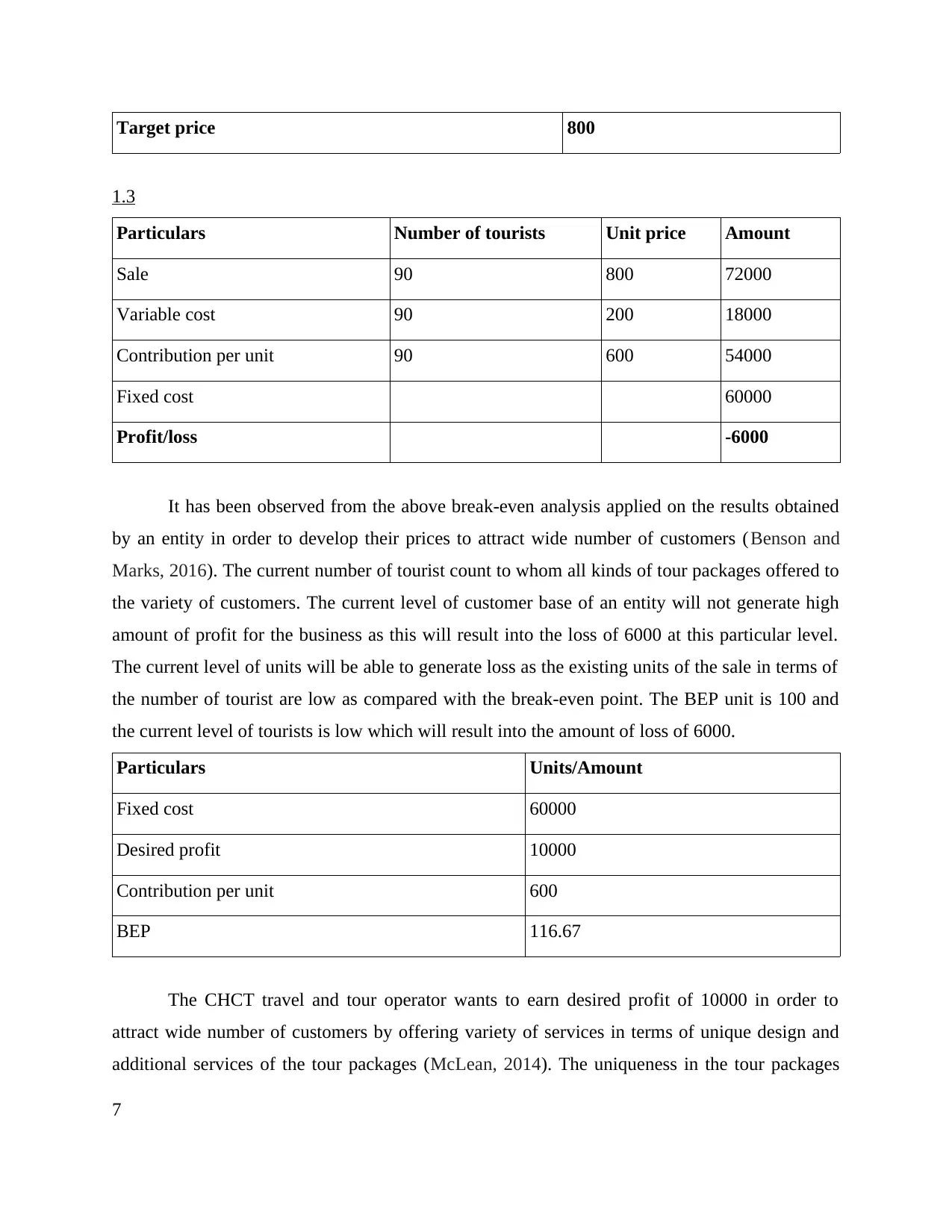
Target price 800
1.3
Particulars Number of tourists Unit price Amount
Sale 90 800 72000
Variable cost 90 200 18000
Contribution per unit 90 600 54000
Fixed cost 60000
Profit/loss -6000
It has been observed from the above break-even analysis applied on the results obtained
by an entity in order to develop their prices to attract wide number of customers (Benson and
Marks, 2016). The current number of tourist count to whom all kinds of tour packages offered to
the variety of customers. The current level of customer base of an entity will not generate high
amount of profit for the business as this will result into the loss of 6000 at this particular level.
The current level of units will be able to generate loss as the existing units of the sale in terms of
the number of tourist are low as compared with the break-even point. The BEP unit is 100 and
the current level of tourists is low which will result into the amount of loss of 6000.
Particulars Units/Amount
Fixed cost 60000
Desired profit 10000
Contribution per unit 600
BEP 116.67
The CHCT travel and tour operator wants to earn desired profit of 10000 in order to
attract wide number of customers by offering variety of services in terms of unique design and
additional services of the tour packages (McLean, 2014). The uniqueness in the tour packages
7
1.3
Particulars Number of tourists Unit price Amount
Sale 90 800 72000
Variable cost 90 200 18000
Contribution per unit 90 600 54000
Fixed cost 60000
Profit/loss -6000
It has been observed from the above break-even analysis applied on the results obtained
by an entity in order to develop their prices to attract wide number of customers (Benson and
Marks, 2016). The current number of tourist count to whom all kinds of tour packages offered to
the variety of customers. The current level of customer base of an entity will not generate high
amount of profit for the business as this will result into the loss of 6000 at this particular level.
The current level of units will be able to generate loss as the existing units of the sale in terms of
the number of tourist are low as compared with the break-even point. The BEP unit is 100 and
the current level of tourists is low which will result into the amount of loss of 6000.
Particulars Units/Amount
Fixed cost 60000
Desired profit 10000
Contribution per unit 600
BEP 116.67
The CHCT travel and tour operator wants to earn desired profit of 10000 in order to
attract wide number of customers by offering variety of services in terms of unique design and
additional services of the tour packages (McLean, 2014). The uniqueness in the tour packages
7
Paraphrase This Document
Need a fresh take? Get an instant paraphrase of this document with our AI Paraphraser
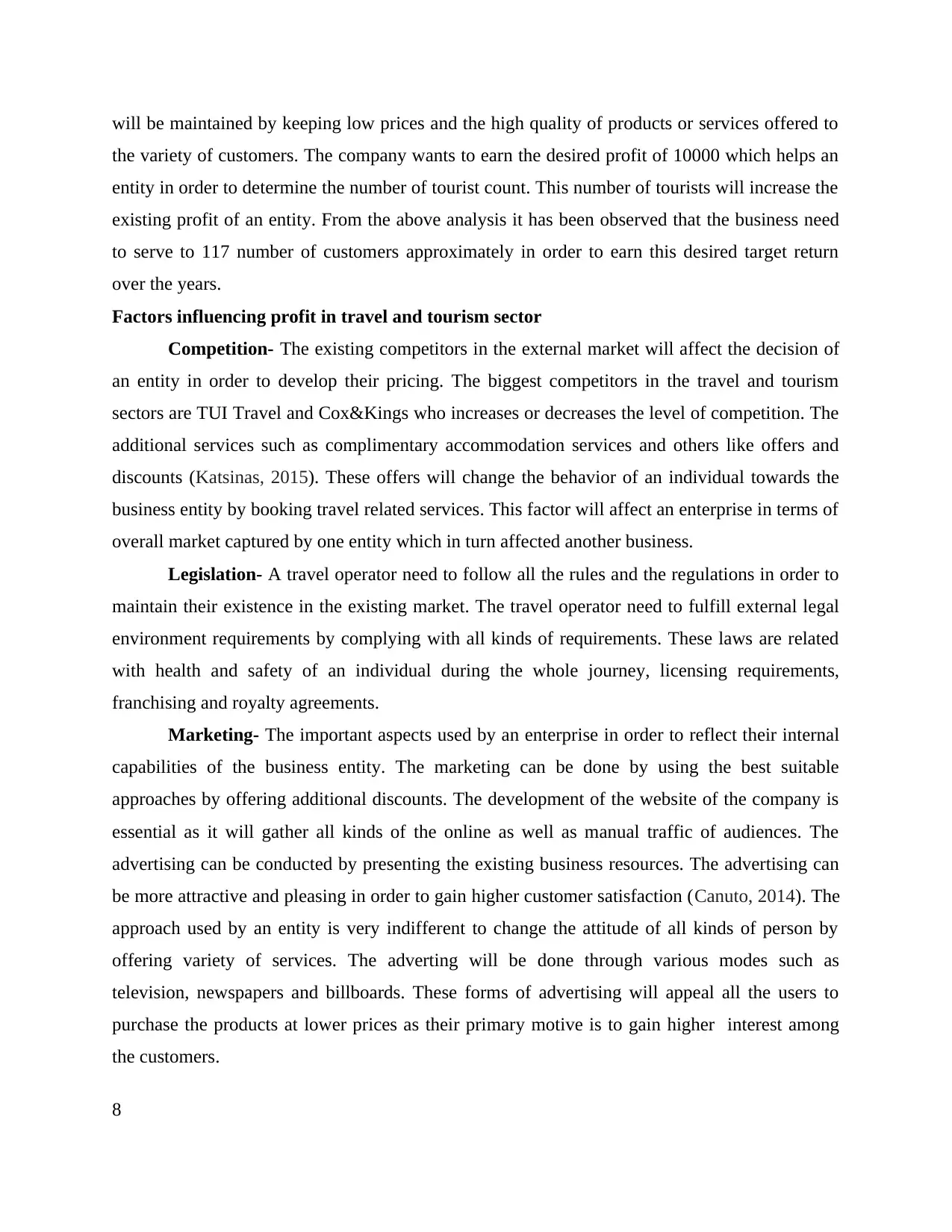
will be maintained by keeping low prices and the high quality of products or services offered to
the variety of customers. The company wants to earn the desired profit of 10000 which helps an
entity in order to determine the number of tourist count. This number of tourists will increase the
existing profit of an entity. From the above analysis it has been observed that the business need
to serve to 117 number of customers approximately in order to earn this desired target return
over the years.
Factors influencing profit in travel and tourism sector
Competition- The existing competitors in the external market will affect the decision of
an entity in order to develop their pricing. The biggest competitors in the travel and tourism
sectors are TUI Travel and Cox&Kings who increases or decreases the level of competition. The
additional services such as complimentary accommodation services and others like offers and
discounts (Katsinas, 2015). These offers will change the behavior of an individual towards the
business entity by booking travel related services. This factor will affect an enterprise in terms of
overall market captured by one entity which in turn affected another business.
Legislation- A travel operator need to follow all the rules and the regulations in order to
maintain their existence in the existing market. The travel operator need to fulfill external legal
environment requirements by complying with all kinds of requirements. These laws are related
with health and safety of an individual during the whole journey, licensing requirements,
franchising and royalty agreements.
Marketing- The important aspects used by an enterprise in order to reflect their internal
capabilities of the business entity. The marketing can be done by using the best suitable
approaches by offering additional discounts. The development of the website of the company is
essential as it will gather all kinds of the online as well as manual traffic of audiences. The
advertising can be conducted by presenting the existing business resources. The advertising can
be more attractive and pleasing in order to gain higher customer satisfaction (Canuto, 2014). The
approach used by an entity is very indifferent to change the attitude of all kinds of person by
offering variety of services. The adverting will be done through various modes such as
television, newspapers and billboards. These forms of advertising will appeal all the users to
purchase the products at lower prices as their primary motive is to gain higher interest among
the customers.
8
the variety of customers. The company wants to earn the desired profit of 10000 which helps an
entity in order to determine the number of tourist count. This number of tourists will increase the
existing profit of an entity. From the above analysis it has been observed that the business need
to serve to 117 number of customers approximately in order to earn this desired target return
over the years.
Factors influencing profit in travel and tourism sector
Competition- The existing competitors in the external market will affect the decision of
an entity in order to develop their pricing. The biggest competitors in the travel and tourism
sectors are TUI Travel and Cox&Kings who increases or decreases the level of competition. The
additional services such as complimentary accommodation services and others like offers and
discounts (Katsinas, 2015). These offers will change the behavior of an individual towards the
business entity by booking travel related services. This factor will affect an enterprise in terms of
overall market captured by one entity which in turn affected another business.
Legislation- A travel operator need to follow all the rules and the regulations in order to
maintain their existence in the existing market. The travel operator need to fulfill external legal
environment requirements by complying with all kinds of requirements. These laws are related
with health and safety of an individual during the whole journey, licensing requirements,
franchising and royalty agreements.
Marketing- The important aspects used by an enterprise in order to reflect their internal
capabilities of the business entity. The marketing can be done by using the best suitable
approaches by offering additional discounts. The development of the website of the company is
essential as it will gather all kinds of the online as well as manual traffic of audiences. The
advertising can be conducted by presenting the existing business resources. The advertising can
be more attractive and pleasing in order to gain higher customer satisfaction (Canuto, 2014). The
approach used by an entity is very indifferent to change the attitude of all kinds of person by
offering variety of services. The adverting will be done through various modes such as
television, newspapers and billboards. These forms of advertising will appeal all the users to
purchase the products at lower prices as their primary motive is to gain higher interest among
the customers.
8
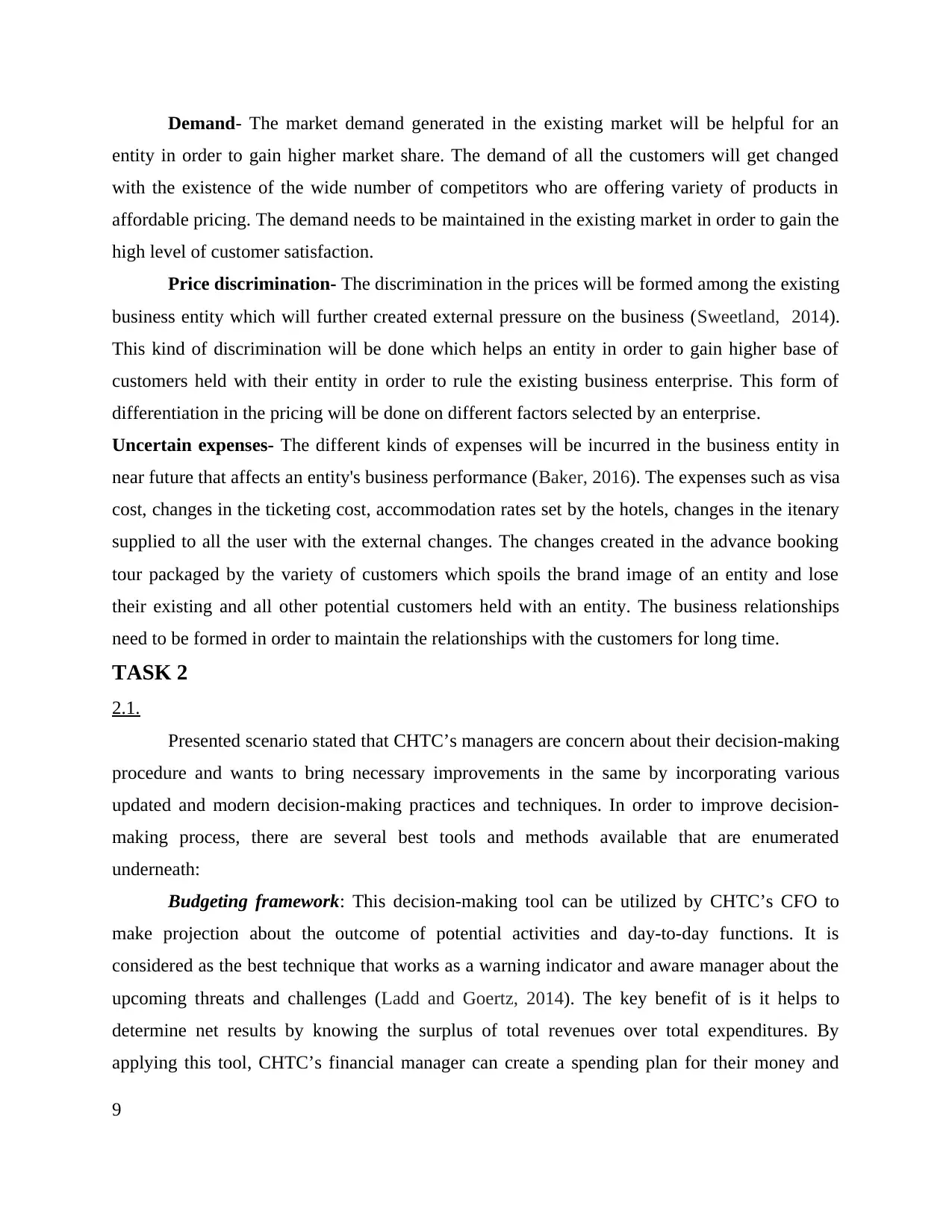
Demand- The market demand generated in the existing market will be helpful for an
entity in order to gain higher market share. The demand of all the customers will get changed
with the existence of the wide number of competitors who are offering variety of products in
affordable pricing. The demand needs to be maintained in the existing market in order to gain the
high level of customer satisfaction.
Price discrimination- The discrimination in the prices will be formed among the existing
business entity which will further created external pressure on the business (Sweetland, 2014).
This kind of discrimination will be done which helps an entity in order to gain higher base of
customers held with their entity in order to rule the existing business enterprise. This form of
differentiation in the pricing will be done on different factors selected by an enterprise.
Uncertain expenses- The different kinds of expenses will be incurred in the business entity in
near future that affects an entity's business performance (Baker, 2016). The expenses such as visa
cost, changes in the ticketing cost, accommodation rates set by the hotels, changes in the itenary
supplied to all the user with the external changes. The changes created in the advance booking
tour packaged by the variety of customers which spoils the brand image of an entity and lose
their existing and all other potential customers held with an entity. The business relationships
need to be formed in order to maintain the relationships with the customers for long time.
TASK 2
2.1.
Presented scenario stated that CHTC’s managers are concern about their decision-making
procedure and wants to bring necessary improvements in the same by incorporating various
updated and modern decision-making practices and techniques. In order to improve decision-
making process, there are several best tools and methods available that are enumerated
underneath:
Budgeting framework: This decision-making tool can be utilized by CHTC’s CFO to
make projection about the outcome of potential activities and day-to-day functions. It is
considered as the best technique that works as a warning indicator and aware manager about the
upcoming threats and challenges (Ladd and Goertz, 2014). The key benefit of is it helps to
determine net results by knowing the surplus of total revenues over total expenditures. By
applying this tool, CHTC’s financial manager can create a spending plan for their money and
9
entity in order to gain higher market share. The demand of all the customers will get changed
with the existence of the wide number of competitors who are offering variety of products in
affordable pricing. The demand needs to be maintained in the existing market in order to gain the
high level of customer satisfaction.
Price discrimination- The discrimination in the prices will be formed among the existing
business entity which will further created external pressure on the business (Sweetland, 2014).
This kind of discrimination will be done which helps an entity in order to gain higher base of
customers held with their entity in order to rule the existing business enterprise. This form of
differentiation in the pricing will be done on different factors selected by an enterprise.
Uncertain expenses- The different kinds of expenses will be incurred in the business entity in
near future that affects an entity's business performance (Baker, 2016). The expenses such as visa
cost, changes in the ticketing cost, accommodation rates set by the hotels, changes in the itenary
supplied to all the user with the external changes. The changes created in the advance booking
tour packaged by the variety of customers which spoils the brand image of an entity and lose
their existing and all other potential customers held with an entity. The business relationships
need to be formed in order to maintain the relationships with the customers for long time.
TASK 2
2.1.
Presented scenario stated that CHTC’s managers are concern about their decision-making
procedure and wants to bring necessary improvements in the same by incorporating various
updated and modern decision-making practices and techniques. In order to improve decision-
making process, there are several best tools and methods available that are enumerated
underneath:
Budgeting framework: This decision-making tool can be utilized by CHTC’s CFO to
make projection about the outcome of potential activities and day-to-day functions. It is
considered as the best technique that works as a warning indicator and aware manager about the
upcoming threats and challenges (Ladd and Goertz, 2014). The key benefit of is it helps to
determine net results by knowing the surplus of total revenues over total expenditures. By
applying this tool, CHTC’s financial manager can create a spending plan for their money and
9
⊘ This is a preview!⊘
Do you want full access?
Subscribe today to unlock all pages.

Trusted by 1+ million students worldwide
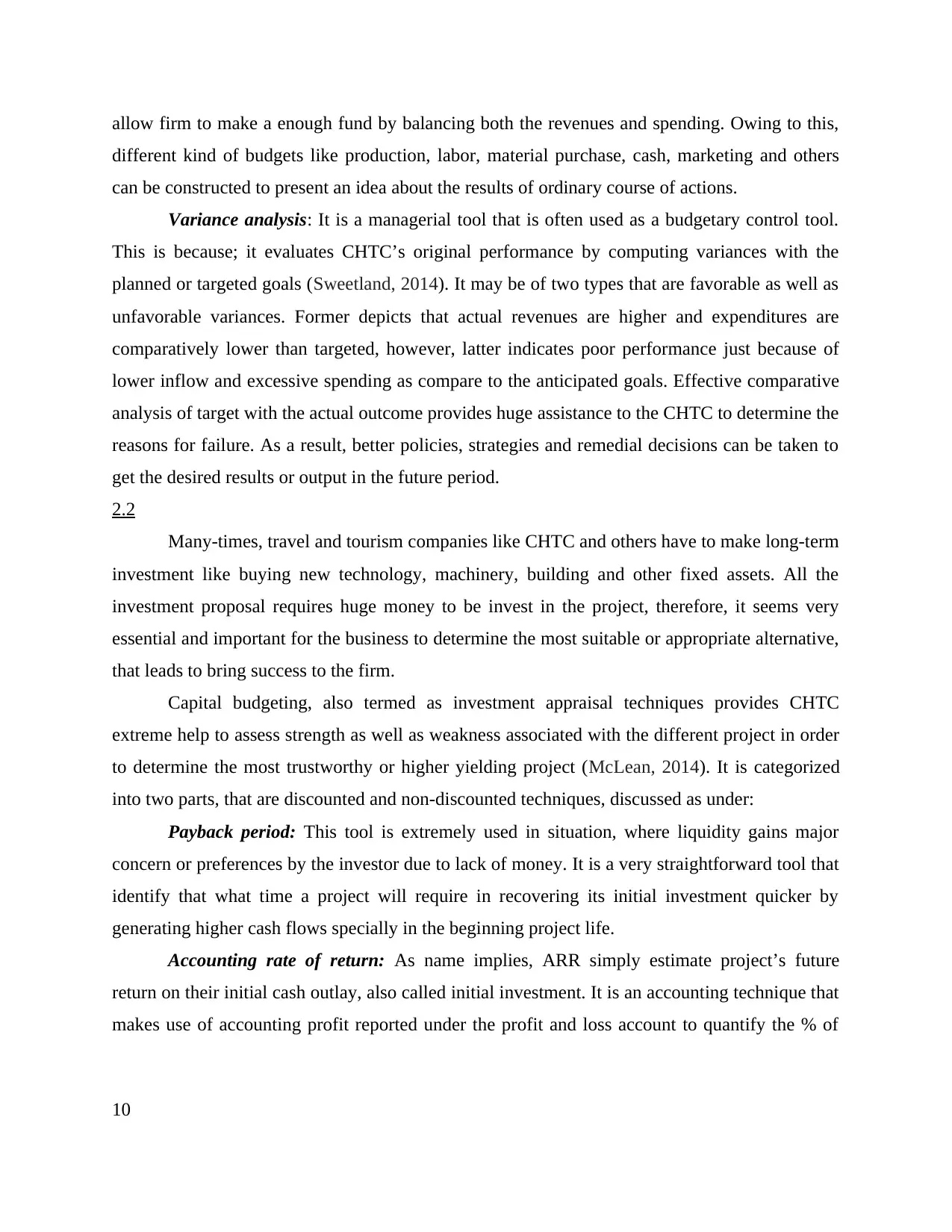
allow firm to make a enough fund by balancing both the revenues and spending. Owing to this,
different kind of budgets like production, labor, material purchase, cash, marketing and others
can be constructed to present an idea about the results of ordinary course of actions.
Variance analysis: It is a managerial tool that is often used as a budgetary control tool.
This is because; it evaluates CHTC’s original performance by computing variances with the
planned or targeted goals (Sweetland, 2014). It may be of two types that are favorable as well as
unfavorable variances. Former depicts that actual revenues are higher and expenditures are
comparatively lower than targeted, however, latter indicates poor performance just because of
lower inflow and excessive spending as compare to the anticipated goals. Effective comparative
analysis of target with the actual outcome provides huge assistance to the CHTC to determine the
reasons for failure. As a result, better policies, strategies and remedial decisions can be taken to
get the desired results or output in the future period.
2.2
Many-times, travel and tourism companies like CHTC and others have to make long-term
investment like buying new technology, machinery, building and other fixed assets. All the
investment proposal requires huge money to be invest in the project, therefore, it seems very
essential and important for the business to determine the most suitable or appropriate alternative,
that leads to bring success to the firm.
Capital budgeting, also termed as investment appraisal techniques provides CHTC
extreme help to assess strength as well as weakness associated with the different project in order
to determine the most trustworthy or higher yielding project (McLean, 2014). It is categorized
into two parts, that are discounted and non-discounted techniques, discussed as under:
Payback period: This tool is extremely used in situation, where liquidity gains major
concern or preferences by the investor due to lack of money. It is a very straightforward tool that
identify that what time a project will require in recovering its initial investment quicker by
generating higher cash flows specially in the beginning project life.
Accounting rate of return: As name implies, ARR simply estimate project’s future
return on their initial cash outlay, also called initial investment. It is an accounting technique that
makes use of accounting profit reported under the profit and loss account to quantify the % of
10
different kind of budgets like production, labor, material purchase, cash, marketing and others
can be constructed to present an idea about the results of ordinary course of actions.
Variance analysis: It is a managerial tool that is often used as a budgetary control tool.
This is because; it evaluates CHTC’s original performance by computing variances with the
planned or targeted goals (Sweetland, 2014). It may be of two types that are favorable as well as
unfavorable variances. Former depicts that actual revenues are higher and expenditures are
comparatively lower than targeted, however, latter indicates poor performance just because of
lower inflow and excessive spending as compare to the anticipated goals. Effective comparative
analysis of target with the actual outcome provides huge assistance to the CHTC to determine the
reasons for failure. As a result, better policies, strategies and remedial decisions can be taken to
get the desired results or output in the future period.
2.2
Many-times, travel and tourism companies like CHTC and others have to make long-term
investment like buying new technology, machinery, building and other fixed assets. All the
investment proposal requires huge money to be invest in the project, therefore, it seems very
essential and important for the business to determine the most suitable or appropriate alternative,
that leads to bring success to the firm.
Capital budgeting, also termed as investment appraisal techniques provides CHTC
extreme help to assess strength as well as weakness associated with the different project in order
to determine the most trustworthy or higher yielding project (McLean, 2014). It is categorized
into two parts, that are discounted and non-discounted techniques, discussed as under:
Payback period: This tool is extremely used in situation, where liquidity gains major
concern or preferences by the investor due to lack of money. It is a very straightforward tool that
identify that what time a project will require in recovering its initial investment quicker by
generating higher cash flows specially in the beginning project life.
Accounting rate of return: As name implies, ARR simply estimate project’s future
return on their initial cash outlay, also called initial investment. It is an accounting technique that
makes use of accounting profit reported under the profit and loss account to quantify the % of
10
Paraphrase This Document
Need a fresh take? Get an instant paraphrase of this document with our AI Paraphraser
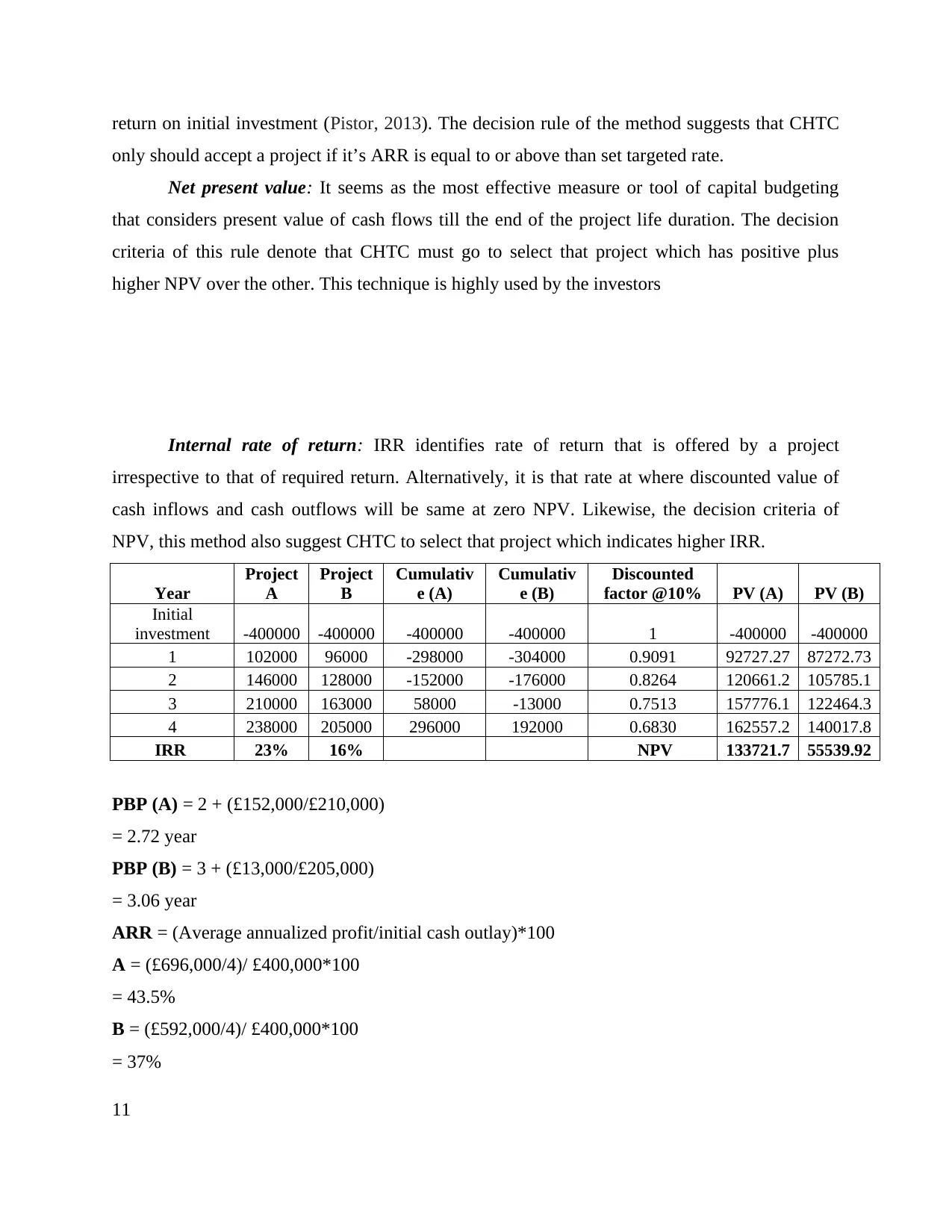
return on initial investment (Pistor, 2013). The decision rule of the method suggests that CHTC
only should accept a project if it’s ARR is equal to or above than set targeted rate.
Net present value: It seems as the most effective measure or tool of capital budgeting
that considers present value of cash flows till the end of the project life duration. The decision
criteria of this rule denote that CHTC must go to select that project which has positive plus
higher NPV over the other. This technique is highly used by the investors
Internal rate of return: IRR identifies rate of return that is offered by a project
irrespective to that of required return. Alternatively, it is that rate at where discounted value of
cash inflows and cash outflows will be same at zero NPV. Likewise, the decision criteria of
NPV, this method also suggest CHTC to select that project which indicates higher IRR.
Year
Project
A
Project
B
Cumulativ
e (A)
Cumulativ
e (B)
Discounted
factor @10% PV (A) PV (B)
Initial
investment -400000 -400000 -400000 -400000 1 -400000 -400000
1 102000 96000 -298000 -304000 0.9091 92727.27 87272.73
2 146000 128000 -152000 -176000 0.8264 120661.2 105785.1
3 210000 163000 58000 -13000 0.7513 157776.1 122464.3
4 238000 205000 296000 192000 0.6830 162557.2 140017.8
IRR 23% 16% NPV 133721.7 55539.92
PBP (A) = 2 + (£152,000/£210,000)
= 2.72 year
PBP (B) = 3 + (£13,000/£205,000)
= 3.06 year
ARR = (Average annualized profit/initial cash outlay)*100
A = (£696,000/4)/ £400,000*100
= 43.5%
B = (£592,000/4)/ £400,000*100
= 37%
11
only should accept a project if it’s ARR is equal to or above than set targeted rate.
Net present value: It seems as the most effective measure or tool of capital budgeting
that considers present value of cash flows till the end of the project life duration. The decision
criteria of this rule denote that CHTC must go to select that project which has positive plus
higher NPV over the other. This technique is highly used by the investors
Internal rate of return: IRR identifies rate of return that is offered by a project
irrespective to that of required return. Alternatively, it is that rate at where discounted value of
cash inflows and cash outflows will be same at zero NPV. Likewise, the decision criteria of
NPV, this method also suggest CHTC to select that project which indicates higher IRR.
Year
Project
A
Project
B
Cumulativ
e (A)
Cumulativ
e (B)
Discounted
factor @10% PV (A) PV (B)
Initial
investment -400000 -400000 -400000 -400000 1 -400000 -400000
1 102000 96000 -298000 -304000 0.9091 92727.27 87272.73
2 146000 128000 -152000 -176000 0.8264 120661.2 105785.1
3 210000 163000 58000 -13000 0.7513 157776.1 122464.3
4 238000 205000 296000 192000 0.6830 162557.2 140017.8
IRR 23% 16% NPV 133721.7 55539.92
PBP (A) = 2 + (£152,000/£210,000)
= 2.72 year
PBP (B) = 3 + (£13,000/£205,000)
= 3.06 year
ARR = (Average annualized profit/initial cash outlay)*100
A = (£696,000/4)/ £400,000*100
= 43.5%
B = (£592,000/4)/ £400,000*100
= 37%
11

Recommendation:
Considering the net results, it can be seen that project A has less PBP of 2.72 year and
higher ARR of 43.5% over project B. Moreover, DCF method also reveals that this project will
have higher NPV and IRR of £133,721.7 and 23% whereas project B has less NPV and IRR of
£55,539.92 and 16% considers project A as viable and profit worthy, henceforth, investment
should be made in that particular project.
TASK 3
3.1
UK is one of the famous tourist destination across the globe, at where, number of tourists
came every year (Ferguson, 2014). There are number of tour operator that offers excellent tour
packaging services to the visitors, TUI travel Groups is a global or leading traveling British tour
operate that serves global customer base. Its monetary performance can be quantified and
measured by using ratio analysis framework.
Ratio analysis is a financial performance evaluation technique, wherein, various ratios are
computed to find out the relationship among several components of the annual financial reports.
Computation of profitability, efficiency, liquidity (short-term payment) and solvency ratios helps
to evaluate each and every element of final reports that are presented here as under:
12
Considering the net results, it can be seen that project A has less PBP of 2.72 year and
higher ARR of 43.5% over project B. Moreover, DCF method also reveals that this project will
have higher NPV and IRR of £133,721.7 and 23% whereas project B has less NPV and IRR of
£55,539.92 and 16% considers project A as viable and profit worthy, henceforth, investment
should be made in that particular project.
TASK 3
3.1
UK is one of the famous tourist destination across the globe, at where, number of tourists
came every year (Ferguson, 2014). There are number of tour operator that offers excellent tour
packaging services to the visitors, TUI travel Groups is a global or leading traveling British tour
operate that serves global customer base. Its monetary performance can be quantified and
measured by using ratio analysis framework.
Ratio analysis is a financial performance evaluation technique, wherein, various ratios are
computed to find out the relationship among several components of the annual financial reports.
Computation of profitability, efficiency, liquidity (short-term payment) and solvency ratios helps
to evaluate each and every element of final reports that are presented here as under:
12
⊘ This is a preview!⊘
Do you want full access?
Subscribe today to unlock all pages.

Trusted by 1+ million students worldwide
1 out of 18
Related Documents
Your All-in-One AI-Powered Toolkit for Academic Success.
+13062052269
info@desklib.com
Available 24*7 on WhatsApp / Email
![[object Object]](/_next/static/media/star-bottom.7253800d.svg)
Unlock your academic potential
Copyright © 2020–2025 A2Z Services. All Rights Reserved. Developed and managed by ZUCOL.





